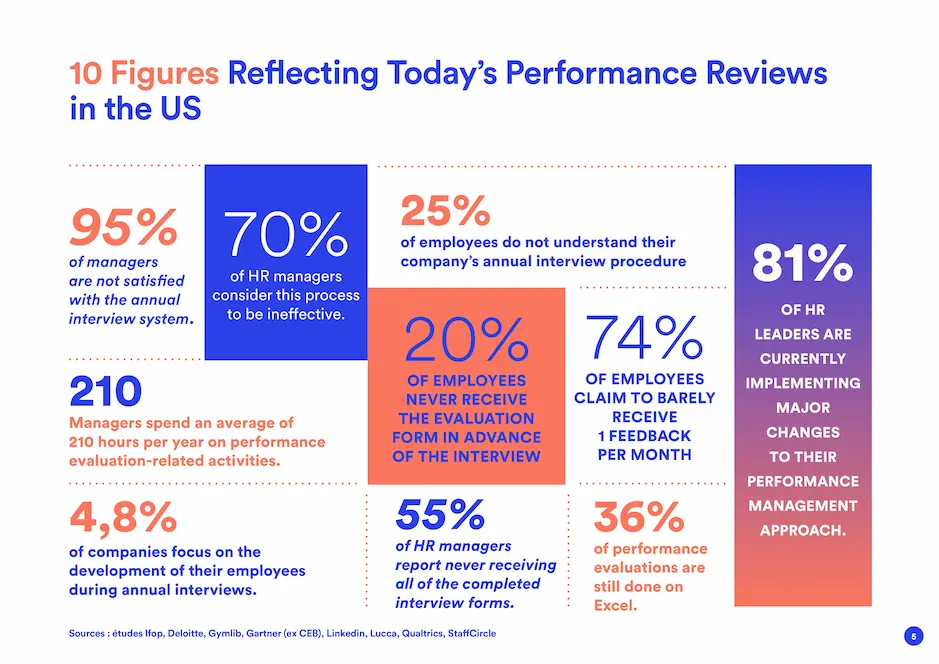Performance Reviews: current overview
Performance reviews are regular catch-ups where you review past work achievements and set future goals, helping you grow and succeed in your job. Over the years, the nature of performance reviews has shifted significantly. Once narrowly centered on evaluating performance, these reviews now encompass a broader focus on employee development. Below, we present 10 key statistics that underscore the necessity of this transformation in today’s approach to performance management
One of the most important changes involves the redefinition of the performance concept itself. Three major changes should be considered:
Regular, in-depth performance reviews
In the past, most managers assessed their employees’ performance once a year, focusing on a limited number of criteria. Today, many employers are opting for more frequent, qualitative assessments, understanding that performance is a dynamic concept that cannot be measured solely by ticking boxes in an appraisal template.
New performance reviews expectations
Another important trend to note involves changing workplace demographics and employee expectations. The incorporation of younger generations to the world of work has challenged the relevance of traditional performance reviews, since the limited focus on results doesn’t account for other things that matter to younger professionals such as recognition of achievements and having meaningful roles .
Advances in digital tools transform performance assessments
Lastly, the development of digital tools, advanced analytics, and Big Data have prompted many organizations to rethink the performance review process beyond an annual event. Let’s look at some useful guidelines that can help HR professionals conduct high-impact reviews.
Best practices for successful performance reviews
Complement formal assessments with regular check-ins
Employee performance is dynamic and fluctuates over time, so ongoing appraisals are the most effective way to assess it. You can schedule informal but regular checkpoints between formal appraisal events, cultivating a culture of constant feedback and open communication. Here are a few suggestions to include in a performance checkpoint.
Effective recognition and positive feedback
Recognition is one of the most powerful tools HR managers can use.
How can we effectively harness the power of recognition as a managerial tool?
A number of criteria need to be met to make recognition a powerful lever:
- Make it specific: give concrete examples of tasks completed, deadlines met or other instances of valuable performance.
- Put it in context: explain the positive implications that the employee’s performance has on the team, department or organization.
- Celebrate successes as a team. According to a PwC study, employees value recognition from their colleagues almost as much as from their managers. Be sure to invite constructive feedback from multiple sources and incorporate it into your words of appreciation.
Not sure how to go about it? Here’s our Guide to positive feedback.
Growth-oriented conversations
This means focusing on professional development plans and showing a willingness to help employees achieve their aspirations, whether through training, mentoring programs or other suitable means. The Emeritus Global Career Impact Survey 2022 revealed that a large majority (89%) of former learners feel increased professional commitment when learning new concepts and skills.
Focus on goals, not just metrics
To ensure that employees contribute to personal and organizational success, their efforts can be measured against short-, medium- and long-term objectives. While concrete metrics have their place in performance appraisals, focusing on objectives helps keep employees motivated and forward-looking. Depending on the size of your company, the OKR method has been widely used throughout the organization.
For example, it helps ensure that everyone is aligned on common goals, which is crucial in large organizations where efforts can easily become siloed. However, this approach requires a robust change management strategy.
For small businesses, OKR methodology enables rapid adaptation in response to market changes, fostering a culture of transparency and accountability from the outset. Nevertheless, challenges such as lack of experience or resources to effectively implement and monitor OKRs can hinder proper implementation.
Incorporate 360-degree assessments
360-degree assessments can provide a more comprehensive view of performance. These collaborative evaluations include feedback from others, including peers and customers. Involving coworkers in the review process can help come up with new solutions to performance issues that affect not only individual workers, but entire teams.
Addressing common challenges in the performance review process
A poor appraisal process can have a negative impact on employee performance, commitment and loyalty.
What are the main challenges of performance assessment?
Here's a list of common problems that HR experts should be aware of: assessment bias, a critical or even negative approach, vaguely formalized expectations, development plans that don't take individual characteristics into account, one-way conversations. All these undesirable behaviors lead to an attitude of resistance to change.
Performance bias
Unconscious bias can subtly influence performance evaluations. It's crucial to be aware of common biases that may arise during the review process. By critically examining your systems, you can enhance objectivity and equity. This is especially vital considering the significant impact that perceived objectivity in evaluations has on employee engagement. When assessments are viewed as objective, employee engagement can surge by 46%. Conversely, perceived inequity in evaluations not only diminishes an employee's motivation but also doubles the likelihood of them considering leaving the organization.
Negativity
Criticism can be very demoralizing, even if it's given with the best of intentions. Be careful about the language you use, and if negative feedback must be given, focus on problem-solving rather than negative appraisals.
Unclear expectations
Never assume that employees know what is expected of them. It's helpful to send out periodic reminders about the areas and standards of performance that will be discussed during the performance appraisal to make sure everyone is on the same page. In addition, meet with the HR team to evaluate metrics and standards and find ways to make them clear and specific.
Generic development plans
One-size-fits-all” development plans often fail to motivate workers to perform at their highest level. Make sure the appraisal process is tailored to each employee’s strengths and weaknesses, and invite their suggestions on how to customize development plans so they can continue to progress and gain recognition, appraisal after appraisal.
One-way conversations
Discussing performance in a traditional "top-down" approach can limit the positive impact of appraisals and can lead to unrealistic or irrelevant objectives being set that fail to engage employees. To avoid one-way conversations, take the initiative to maintain an open dialogue, so that employees feel comfortable offering their perspective on performance-related issues, not just during the appraisal itself but throughout their time with the company.
Resistance to change
All the problems mentioned above can lead to employee resistance to implementing the changes or tasks needed to improve their performance. Tackling this challenge proactively involves fostering a culture of openness to change with a solid strategy of continuous listening. This can help to better understand employees’ concerns and present changes in an appealing way that helps them advance in their careers.
Conclusion
HR leaders find themselves at a pivotal moment when productivity needs to be boosted while maintaining the momentum of their talent. We recommend amplifying the impact of collective performance through flexible assessment processes, supported by technology. Involving employees by asking for their recommendations, focusing on skills development objectives and offering genuine recognition are just some of the key ways to make the performance review process more effective.
This article also offered advice on how to proactively tackle common challenges that can interfere with this HR process, including bias awareness, negativity, unclear expectations, generic performance improvement plans, and conversations that don't take the employee's perspective into account. Following the suggestions listed above is the first step to harnessing performance reviews as the excellent talent development tool they are.









